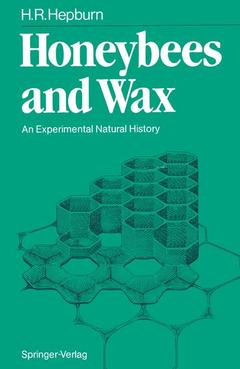Honeybees and Wax, Softcover reprint of the original 1st ed. 1986 An Experimental Natural History
Langue : Anglais
Auteur : Hepburn H. Randall

"Instead of dirt and poison we have rather chosen to fill our hives with honey and wax; thus furnisning mankind with the two noblest of things, which are sweetness and light". Mindful of Swift's dictum, this compilation is offered as an exhaustive coverage of a smallish literature on the synthesis and secretion of beeswax, its elaboration into combs and the factors which bear on the execution of these processes by honeybees. To codify any aspect of the biology of an animal of agricultural importance is to sift through myriad observations and experiments, centuries old, that come down to us enshrouded in the folk literature. It is evident that wars and languages have also acted as barriers to the dissemination of knowledge about honeybees. Thus, particular care has been given to the primacy of discovery and its con textual significance. I have endeavoured to not over-interpret data and to allow the authors' works to speak for themselves. I have also tried to indicate some of the more obvious gaps in our knowledge of honeybees in relation to wax and to suggest some directions as to where we might proceed, aided by discoveries made on other animals and plants. This was done to remind the seasoned bee-hand of our general neglect of beeswax biology, historically constituting less than a percentage point of the apicultural literature.
1 Introduction.- I: The Nature and Production of Beeswax.- 2 The Origin of Beeswax: an Historical Perspective.- The Classical Era.- The Renaissance.- The Enlightenment.- 3 Source of Secretion.- The Cuticle: the Search for Holes.- Filaments or Microtubules?.- Tracheation.- The Epidermis.- Fat Body and Oenocytes.- Synchronising Cellular Activity.- 4 Rise and Fall of the Epithelium.- Age and the Division of Labour.- Rejuvenation of Old Bees.- Newly Settled Swarms.- Laying Workers.- Racial Differences.- Tragedies and Disease.- Winter.- Cell Height and Secretory Performance.- 5 Composition and Synthesis of Beeswax.- Gross Composition of Beeswax.- The Proteins of Beeswa.- Proof of Synthesis.- Routes of Synthesis.- Recent Refinements.- 6 Food Conversion Ratios in the Production of Beeswax.- The Agricultural Chemists.- Cumulative Ratios.- Direct Costs of Wax Production.- Measures of Conversion Efficiency.- Temperature and Wax Production.- II: The Manipulation Of Wax By Honeybees.- 7 Manipulation of Wax Scales.- Removal of the Wax Scales(Casteel 1912).- The Scale-Removing Organ(Casteel 1912).- Mandibulation of the Scales.- Free Scales (Casteel 1912).- Partial Removal of Scales(Casteel 1912).- Producers and Builders(Casteel 1912).- 8 Metamorphosis of Wax.- The Structure of Virgin Scale Wax.- Optical and Diffraction Studies.- Crystallography.- Mechanical Properties of Wax.- Maturation of Newly Constructed Combs.- Foreign Substances.- 9 The Construction of Cells.- Minor Building Operations.- Inception of the Nest.- The Irregular Nature of Cells.- Recognition of Cell Patterns.- Interlude: Bigger Cells, Bigger Bees.- Assessment of Cell Size.- The Cell Base.- 10 The Construction of Combs.- Parallelism between Combs.- Festoons and Torsion.- Festoons and Comb Growth.- Evidence of a Sense of Equilibrium.- Application of the Sense of Equilibrium.- The Orientation of Combs.- III: Stimuli for Production and Manipulation of Wax.- 11 The Nectar Flow.- The Stimulus of Spring.- Winter, the Off-Switch.- Nectar, the Unqualified Stimulus.- Hoarding Assays.- Comb as a Stimulus.- The Honey Stomach.- 12 Pollen and Wax Production.- Essential role of pollen.- Quantitative Requirements.- Compartmental Effects.- Physical Presence of Pollen.- Pollen Pheromones.- 13 The Brood Nest.- The Meaning of Brood.- Efficacy of Open Brood.- Brood-Rearing and Honey Storage.- 14 The Queen.- The Construction of Queen Cells.- Comb Construction and the Queen.- 15 Space and Density.- Nest Founding.- Volume of a Potential Nest.- The Arrangement of Space.- Density Versus Space.- Reduction of Nest Size.- Quality of Space.- References.- Author Index.
Date de parution : 11-2011
Ouvrage de 205 p.
17x24.4 cm
Disponible chez l'éditeur (délai d'approvisionnement : 15 jours).
Prix indicatif 105,49 €
Ajouter au panierThèmes de Honeybees and Wax :
Mots-clés :
© 2024 LAVOISIER S.A.S.



